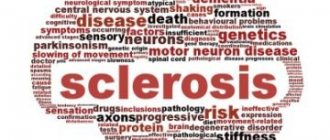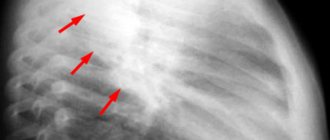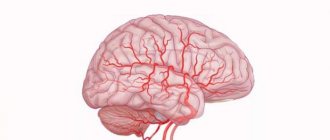One of the important areas in medicine is the treatment of multiple sclerosis. Nerve endings that have lost their protective myelin sheath due to improper functioning of the immune system are negatively affected and damaged, causing the brain center to lose communication and control over the rest of the body. All this leads to the development of multiple sclerosis. No way has yet been found to restore the protective shell. Today, a new method of treating multiple sclerosis with stem cells has already been developed.
Its symptoms manifest themselves differently and depend on the specific stage of the disease. In advanced, severe stages of the disease, patients are often no longer able to move independently or even speak. Many people are interested in whether multiple sclerosis can be cured and how many people live with it. It is difficult to diagnose damage to the sheath of nerve fibers, since the symptoms of multiple sclerosis may not manifest themselves for a long time.
Unfortunately, to date, there is no complete treatment for this disease. Now it is only possible to stop the further development of the disease, slow down its progressive course and reduce the manifestation of symptoms.
Reasons for appearance
When treating multiple sclerosis, it is necessary to determine its origin, but today it is difficult to determine the exact causes of its manifestation. An important role in the development of the disease is played by deteriorating environmental conditions and the widespread spread of various infections. The Epstein-Barr virus is today considered the most popular infectious pathogen leading to the development of disease mechanisms. A way to deal with it has not yet been found.
Studies in countries with cold climates show that those who eat little foods low in vitamin D may also be susceptible to this disease. It was found that the activity of some regulatory T-lymphocytes, which can influence the mechanism of occurrence and exacerbation of multiple sclerosis, depends on the level of vitamin D in the body.
In this case, the immune system perceives some of its own cells and tissues as foreign and turns on a defense mechanism, destroying them. In multiple sclerosis, the myelin layer acts as a mistakenly perceived foreign agent - this is a specific substance that forms a protective sheath around the nerve threads of the brain and spinal cord. This substance is similar to the insulating layer of electrical wires; if this layer is damaged, then the electrical signal traveling along the length of the cable can be blocked.
To find out how to stop multiple sclerosis, you need to know what factors influence its development. A direct relationship has been discovered between the development of the disease and genetic predisposition to this disease. However, some doctors and scientists still have not figured out how the disease may manifest itself differently in people with a common genetic predisposition. In one group of people it manifests itself, in another it does not. A theory has been put forward: external factors such as sun rays, eating habits, hidden or chronic diseases, hypovitaminosis, any negative influence of toxins from the external environment with a genetic predisposition can be a trigger for the activation of processes leading to this health problem.
It has been noted that smoking is also considered one of the factors provoking the risk of the disease. Therefore, in order to prevent multiple sclerosis, if you have a predisposition to it, it is better to give up this bad habit.
Treatment of SPMS
Treatment is primarily PED. These drugs are approved and prescribed to patients with relapsing-remitting forms of MS, as well as those with SPMS who continue to experience relapses.
Thus, a person who was on one of the interferons continuously during the initial relapsing-remitting phase of the disease will likely continue to take it until the doctor determines that the drug is no longer doing its job of controlling disease activity. At that time, your doctor will likely recommend changing your medication to Novantrone®. This is so far the only drug approved for this disease. The main substance is mitoxantrone, of chemotherapeutic origin. Sometimes it may be prescribed for exacerbations of relapsing MS.
Don't forget that:
- The quality of symptoms should be constantly monitored in order to maintain comfort, performance and improve quality of life.
- Emotional health and well-being can be achieved even in the presence of chronic illness and disability.
Risk factors
There are certain factors that can positively influence the process of the disease.
- The risk group includes women from 20 to 40 years old. According to research, the disease most often manifests itself among people in the specified age range. It has been noticed that if we compare men and women, women are more often susceptible to damage to nerve fibers.
- Genetic predisposition. In the case where blood relatives had similar problems, the likelihood of the disease increases by approximately 1–3%. But heredity is not a decisive factor in the manifestation of sclerosis. Research shows that if one twin is sick, the other twin has only a 30% chance of contracting the disease.
- Infectious processes directly influence the development of the disease. How viruses are related to the destruction of the myelin layer by the human immune system is still unclear. Inflammatory processes in the intestines, thyroid disorders or type 1 diabetes increase the risk of the disease.
- Surprisingly, it is true that the occurrence of multiple sclerosis has a direct relationship with race. Asians, Africans and Americans have a lower risk of developing this disease than white Europeans. Multiple sclerosis occurs especially often among Europeans who live in the Northern regions. It's difficult to protect yourself from it.
Symptoms
Any health problem manifests itself through certain symptoms, however, in the case of multiple sclerosis, the signs of its manifestation depend on the location of the damaged area of nerve fibers. Exacerbation often occurs in multiple sclerosis. Among them are several of the most common:
- dizziness. But you should not perceive any manifestation of a symptom as a sign of multiple sclerosis; you should pay attention to other manifestations of the disease;
- numbness in multiple sclerosis. It can appear only on one side or cover the entire lower part of the body;
- weakness and increased fatigue, spasticity in multiple sclerosis;
- violation of movement coordination;
- sharp attacks of pain in various parts of the body, tingling;
- Acute pain in multiple sclerosis occurs in some parts of the body when turning the head. Therefore, anesthesia is sometimes used for multiple sclerosis;
- double vision, blurred outlines of objects;
- partial or complete loss of vision in one or both eyes.
The disease is characterized by a state of temporary improvement and absence of symptoms, but this is a deceptive state. During this period of time, patients believe that the disease has stopped and receded, however, this is only remission of the disease. Sometimes the manifestation of symptoms of the disease increases with an increase in the patient’s body temperature. Sometimes the pain is so severe that it becomes difficult to manage without anesthesia for multiple sclerosis.
Stages of the disease and their symptoms
The severity of the condition of patients with MS has been determined for many years using the expanded EDSS scale . The technique has become widely popular due to the ability for specialists to objectively assess the degree of disability of each patient.
According to the points awarded (from 0 to 9.5), it is determined how affected the functions of the main body systems are. And the distribution of MS at stage is carried out according to this scale.
Light
Relapsing-remitting MS: after a period of exacerbation, the patient recovers completely or partially .
The duration of remission can be a week or several years. The patient complains of a partial decrease in muscle strength and increased fatigue. Upon examination, individual neurological signs of the disease are noted: decreased pain, tactile and vibration sensitivity in one or both limbs.
Changes in gait are still weakly manifested, but obvious oculomotor disturbances and scotoma (narrowing of the visual field) as a result of damage to the optic nerve are already observed.
Moderate
This category includes patients not only with relapsing-remitting, but also with a progressive course of the disease. The patient has significant difficulties with voluntary movements due to weakness in a certain muscle group (monoparesis).
Often all the signs of static or dynamic ataxia appear (miscoordination of movements, loss of balance in a standing position). And in many patients, both monoparesis and ataxia are combined.
Up to a certain point, all self-care skills are intact, the patient is able to remain in an upright position for up to 12 hours during the day, but the state of weakness becomes more and more pronounced.
Over time, the condition worsens, independent walking without rest and support becomes possible only for short distances: first from 500, and later only up to 100 m. The patient is able to spend only part of the day at work.
The completion of this stage and the transition to complete disability occurs from the moment when the patient begins to need first unilateral, and a little later, bilateral support when walking even over minimal distances.
Heavy
Patients at this stage are disabled people of group 1. The final stage progresses from activity in a wheelchair to complete immobility and helplessness.
First, the patient loses the ability to sit in a chair all day and begins to need assistance when moving.
Subsequently, he is forced to confine himself only to the bed, but still serves himself with his hands. Over time, self-care skills are completely lost, and the patient is only able to communicate and eat while lying down. The final manifestations of progressive MS are the loss of the swallowing reflex , the inability to eat and speak.
Exacerbation of multiple sclerosis, what are the prerequisites?
Often the patient has additional complications of multiple sclerosis, accompanied by painful sensations. Among them may be:
- the appearance of cramps, loss of elasticity, stiffness of body muscles;
- impairment of motor functions of any part of the body, paralysis. The lower part of the body is most often affected, and weakness in the legs is observed with multiple sclerosis. As a result, muscles atrophy and legs lose weight;
- disruption of the urinary tract, gastrointestinal tract, changes, disruption of sexual life;
- degradation of mental performance, increased incidence of memory loss, difficulty concentrating;
- development of depression;
- manifestation of epilepsy;
- spasticity in multiple sclerosis.
Diagnostics
Unfortunately, multiple sclerosis is also a difficult disease to diagnose, since its symptoms can appear and subside for a certain period of time. Medical professionals often resort to the practice of prescribing certain diagnostic methods, the results of which can exclude other possible pathologies with similar symptoms. For severe pain, anesthesia for multiple sclerosis is sometimes prescribed.
- The main procedure is a complete blood count and ESR analysis. Thanks to the results obtained by examining the blood, it is possible to discard suspicions of other infectious infections and inflammatory processes.
- A lumbar puncture or lumbar puncture for a problem is done by inserting a needle into the subarachnoid space of the spinal cord at the lumbar level. This is done to extract a small amount of cerebrospinal fluid for testing in the laboratory. Anesthesia is not required for this procedure. A puncture for this problem makes it possible to determine the level of leukocytes and immunoglobulins, which indicate the presence of multiple sclerosis, and also to exclude some neurological diseases caused by infectious viral agents, but not related to the disease under study. The procedure can be quite painful, so in some cases anesthesia is used for multiple sclerosis.
- Magnetic resonance imaging can diagnose multiple sclerosis in patients using powerful three-tesla equipment. During the examination, it is carried out using electromagnetic and radio wave radiation, which makes it possible to better visualize inflammatory changes in internal organs and in brain tissue; you can see changes confirming the destruction of myelin. However, the examination will not guarantee an accurate diagnosis, since this type of damage can be caused by other causes, such as lupus.
- The study of evoked potentials of the brain will determine the integrity of visual, auditory and other types of nerves. During the examination, the electrical signals with which the brain responds to specially sent stimuli are measured. In this test, doctors use visual or electrical stimuli to measure brain activity and the response of the unequal system while sending weak electrical impulses to the limbs.
- Another popular procedure is an immunogram for multiple sclerosis. Surgical methods are not yet often used, however, a method of treating multiple sclerosis with stem cells has already been invented.
Atypical malignant
Marburg disease
Malignant and rapidly progressive course of MS. Periods of clear remissions are not observed.
It is characterized, as a rule, by an aggressive onset and, for the most part, damage to the brain stem . In addition to the trunk, the lesions spread to the cervical spinal cord and optic nerves.
The patient has pronounced motor disorders, bulbar syndrome (speech and voice disorders) and paroxysmal hypertonicity in the extremities. Along with visual acuity, all cognitive functions sharply decrease.
In addition to MRI, diagnosis requires a biopsy to rule out an abscess or brain tumor . Marburg disease sometimes responds to immunomodulators, steroids, and immunosuppressive therapy, but most often the outcome is poor.
Within several months, disturbances in consciousness to the point of coma are possible. From the first manifestation of symptoms to the death of the patient, only about 1 year can pass.
Flu in multiple sclerosis
Important! If a patient suddenly falls ill with ARVI due to multiple sclerosis, then it is necessary to immediately go to the doctor and be under his supervision.
It is necessary to additionally take antiviral and antimicrobial drugs (amixin, cycloferon for infections, acyclovir, ingavirin, fluconazole, dimethyl fumarate and Wobenzym). It is necessary to isolate the patient from other family members. In addition to treatment with the above medications, it is worth taking additional vitamins. Even if the patient has already recovered from a cold, a visit to the attending physician is still necessary.
ARVI in multiple sclerosis is quite common. During the treatment process, such drugs as rimantadine for prevention, Kagocel for the first signs of a cold are suitable. When using medications for multiple sclerosis, it is important that they be combined with cold medications.
Is multiple sclerosis curable or not?
How to get rid of multiple sclerosis? Unfortunately, it has no cure in the traditional sense. All the efforts of doctors who are aimed at eliminating the disease are actually aimed at slowing the course of the disease, reducing manifestations and alleviating symptoms. Many patients do not require treatment for multiple sclerosis because the symptoms are minor.
An important role in increasing the number of treatments for multiple sclerosis is played by the introduction of medications that change the clinical picture of the disease for the better. For example, immunoglobulins when symptoms appear.
The list of available medications is quite wide and the choice of a specific medication depends on the individual characteristics of the pathology. Medicines can be divided into 3 groups:
- immunomodulators that regulate the activity of the immune system (polyoxidonium in some cases);
- blockers of immune cells through the blood-brain barrier, the main function of which is to maintain brain homeostasis;
- stimulators of immune cell sequestration – a breakthrough in the treatment of multiple sclerosis; immune cell destroyers (ocrelizumab).
The most popular drugs for the treatment of multiple sclerosis:
- Hormone therapy is the use of steroid hormonal drugs of the subclass Corticosteroids. This treatment method helps reduce inflammatory foci. The drugs can be taken either orally in tablets or by injection. However, these medications also have side effects, for example, rapid weight gain, hypertension, and sudden mood swings. Hormones are not recommended for long-term use, as long-term use of the drug may increase blood sugar levels, increase the risk of viral infections, and even increase the risk of developing cataracts.
- Antiviral drugs - interferon-beta 1b slow down the rate of manifestation of disease symptoms. They also have some side effects in the form of liver dysfunction. In this case, sometimes they resort to Berliotion. Therefore, before taking interferon-beta 1b, you must consult a doctor and undergo the appropriate tests.
- Copaxone or glatiramer acetate. It acts by blocking the processes of destruction of the myelin layer of nerve fibers, which are controlled by the immune system. Injections are administered subcutaneously once a day.
- Fingolimod or Gilenya is an immunosuppressive drug that suppresses immune cells in the lymph nodes. Taken once a day orally. Side effects include slow heartbeat, hypertension, and temporary blurred vision. Indicated only for those patients who have had chickenpox.
- Natalizumab is currently the most common second-line treatment for multiple sclerosis. It acts by opposing the movement of cells produced by the immune system towards the tissues of the brain and spinal cord. Long-term use of such medications for the treatment of multiple sclerosis can lead to the appearance of a rare infectious disease of the central nervous system - progressive multifocal leukoencephalopathy, and this, in turn, can lead to the death of the patient.
- Mitoxantrone or novantrone is a cytostatic drug that acts as an immunosuppressant. It is used in extremely severe cases of multiple sclerosis, as it has a negative effect on the heart and contributes to the development of leukemia.
- Solumedrol, Cytoflavin, Cerebrolysin for multiple sclerosis are also sometimes effective. However, the cost of these medications may exceed the threshold of 600 rubles.
Research
Much of the research is focused on myelin repair. Often clinical trials are aimed at reducing disease activity and studying the detailed behavior of the disease as it progresses .
Early clinical trials for the treatment of SPMS produced disappointing results. Trials of weekly intramuscular (Avonex®) and thrice weekly (Rebif®) interferon beta 1a failed to show beneficial effects on disease progression. One study of interferon beta-1b (Betaseron®) conducted in Europe had positive results, but a re-trial done in North America failed to demonstrate a similar effect.
Despite these negative trial experiences, researchers and clinicians have found that people with SPMS who have ongoing flare-ups or other signs of inflammatory activity on MRI may experience benefit from these drugs. Many clinical trials of other drugs are underway for the treatment of progressive forms of MS.
Other medications and possible procedures
Sometimes medications that target specific problems are used to combat symptoms. For example, when the activity of the immune system is blocked, there is a risk of viral infections.
For muscle stiffness and cramps, muscle relaxants are prescribed, which are aimed at relaxing muscle tissue and reducing spasticity. Sometimes drugs are used for anesthesia for multiple sclerosis. In some cases, medications are prescribed to help reduce body fatigue, antidepressants, and medications to normalize the functioning of the urinary tract.
To normalize the mental state, they often resort to sedatives (afobazole for mild mental disorders, glycine, glutamic acid, grandaxin, mexidol for multiple sclerosis). To regulate blood sugar levels, medications such as thiogamma and trental are sometimes prescribed for diabetic antiopathy.
One of the effective treatment methods is plasmaphoresis. The action of this procedure is aimed at separating red blood cells from blood plasma mechanically. Used in advanced forms of multiple sclerosis to eliminate severe symptoms.
Physical therapy can help reduce symptoms. Experts will tell you which exercises will be most effective.
Lately, apitherapy has been gaining popularity. Doctors began to often use dietary supplements based on api products, which strengthen the body's immune system by stimulating the production of natural anti-inflammatory hormones. There is an opinion that the use of the stiotron device can lead to positive results, however, this has not yet been proven. Research is being conducted on the treatment of multiple sclerosis with stem cells.
It is important to make the decision to choose one or another treatment method in consultation with your doctor. It should be borne in mind that the possibility of changing treatment should be taken into account if the chosen strategy is unsuccessful.
FAQ
My doctor said that I now have a secondary progressive course. But why did this happen, I regularly took the medications prescribed to me. Did I do something wrong?
No, everything was probably done correctly. This is a common process when the relapsing-remitting course passes into the stage of secondary progression. Despite the fact that DMTs can reduce the number of relapses and damage to the central nervous system in relapsing forms of MS, during the transition the disease begins to progress, which is not yet possible to influence.
Can we assume that the secondary progressive course will lead me to a wheelchair?
A secondary progressive course means that a transition has already occurred from a relapsing-remitting course, characterized as a course full of foci, to a course of slow progression of the disease, to loss and degeneration of nervous tissue. During this course, people experience relapses less and less often, and at some point they stop and patients begin to experience a constant worsening of symptoms, sometimes alternating with improvements. The rate at which the disease progresses varies from patient to patient, as do the symptoms observed. This may mean that some people experience the onset of disability more than others. However, after a long time, two out of three patients will still be able to move independently. However, they may also need mobility aids such as a cane or walker. Some may choose a car, scooter or motorized wheelchair to travel long distances. Some may require a wheelchair full-time.
If Novatrone® is the only approved treatment for SPMS, why is this drug not used by every patient with this condition?
Novatrone® was originally developed as a drug to fight cancer and was used as an immunosuppressant to treat MS. Decreased immunity means the body's susceptibility to other diseases and other levels of infections. In addition, the risk of developing cardiovascular diseases increases. Due to various risks, Novatrone® is used in extreme cases.
I was diagnosed with secondary progressive multiple sclerosis, but I was not diagnosed with RRMS. How is this possible?
If your doctor is sure that you have a secondary progressive course of the disease, this means that the stage of the relapsing-remitting course was passed without pronounced symptoms and was not diagnosed in time. Often, young people experiencing RRMS do not notice the symptoms, since they are mild and temporary. For example, experiencing mild spasticity or sudden blurred vision that later goes away on its own without consulting a doctor, the patient may miss RRMS.
Rehabilitation for multiple sclerosis
If you have health problems of this kind, you must follow a certain lifestyle that will alleviate the course of the disease.
It is necessary to give the body a rest. Fatigue in multiple sclerosis is one of the symptoms of this disease, so regular rest will help the body feel better. Regular physical aerobic exercise will increase muscle tone, improve coordination of movements, reduce spasticity in multiple sclerosis, make the body stronger and reduce stress and possible depressive states. It is worth taking a closer look at sports such as yoga and doing breathing exercises, this will help avoid the accumulation of stress. It is worth enriching the diet with fortified folic acids and lecithin for multiple sclerosis.
In rehabilitation for multiple sclerosis, you should not allow your body temperature to rise. In this condition, the symptoms intensify, so you need to periodically take a cool shower. Baths and saunas are contraindicated if you have such health problems.
Innovations in the treatment of multiple sclerosis using stem cell transplantation
Today, new treatment methods are being developed. A new discovery in the field of medicine – stem cells. Stem cell transplantation for multiple sclerosis has had a positive effect on patients, which was not previously achieved by other drugs (fluorosamine, methotrexate, dexamethasone, thioctic acid, emoxypine, alemtuzumab in the treatment of the disease, pulse therapy).
After stem cell transplantation, many patients experienced long-term remission of the disease, however, symptoms of the disease may reappear several years later. However, this method is still at the stage of development and further research. Treatment of multiple sclerosis with stem cells has already been tried by many patients who claim that this is one of the best methods they have ever tried.
For Russia, this technique is also considered accessible; it is practiced in the best clinics in the country. The first operations to treat multiple sclerosis with stem cells were successful.
What to Remember After Diagnosis of SPMS
If you or a loved one is diagnosed with SPMS, there are a few things to keep in mind.
- First, it is important to know that entering the SPMS phase from RRMS is not your fault. In fact, most people will eventually switch to HFRS, although the speed at which this transition occurs is still unclear. This is because the advent of new disease-modifying treatments is causing progress to be significantly slower for some people.
- Secondly, it is important to note that, like RRMS, the symptoms of SPMS are variable, as is the rate of progression, meaning that some people are more likely to become disabled than others.
- Third, if MS progresses, your neurologist will likely consider rehabilitation interventions, in addition to your medications, to optimize your functioning and maintain muscle strength and walking.
The bottom line here is that diagnosing SPMS requires a combination of diagnostic modalities, including a thorough neurological examination and repeated MRIs. As with relapsing remission multiple sclerosis, there are no quick or accurate tests. Instead, the diagnosis is clinical and based on the doctor's ability to piece things together.












